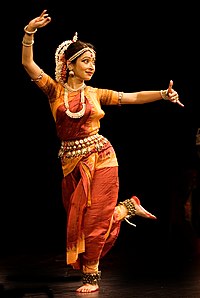Dance in India covers a wide range of dance and dance theatre forms, from the ancient classical or temple dance to folk and modern styles.

Three best-known hindu deities, Shiva, Kali and Krishna, are typically represented dancing. There are hundreds of Indian folk dances such as Bhangra, Bihu, Ghumura Dance, Sambalpuri, Chhau andGarba and special dances observed in regional festivals. India offers a number of classical Indian dance forms, each of which can be traced to different parts of the country. The presentation of Indian dance styles in film, Hindi Cinema, has exposed the range of dance in India to a global audience.
Classical Indian dance
Main article: Classical Indian dance
Each form represents the culture and ethos of a particular region or a group of people. The criteria for being considered as classical is the style's adherence to the guidelines laid down in Natyashastra by the sage Bharata Muni, which explains the Indian art of acting. Acting or natya is a broad concept which encompasses both drama and dance.
Indian classical dance is a misnomer, as actually dance refers to natya, the sacred Hindu musical theatre styles. Its theory can be traced back to the Natya Shastra of Bharata Muni (400 BC). The Sangeet Natak Akademi currently confers classical status on nine "dance" forms:[citation needed]
Those who worship Vishnu are considered Vaishnavas. The dance style performed by Sri Krishna (an Avatar of Vishnu) and the gopis in Vrindavan is called rasa-lila, and is considered as a form of devotional dance. Many other Indian classical dances are used to illustrate events from the Puranas related to or describingVishnu.
[edit]Hindi films
Main articles: Hindi dance songs and Indian song and dance
Dance in early Hindi films, was primarily modelled on classical Indian dance styles and particularly those of historic northern Indian courtesans (tawaif), or folk dances. Modern films often blend this earlier style with Western dance styles (MTV or in Broadway musicals), though it is not unusual to see Western pop and adapted classical dance numbers side by side in the same film. The hero or heroine will often perform with a troupe of supporting dancers. Many song-and-dance routines in Indian films feature unrealistically instantaneous shifts of location and/or changes of costume between verses of a song. If the hero and heroine dance and sing a pas de deux (a French ballet term, meaning "dance of two") often staged in beautiful natural surroundings or architecturally grand settings, referred to as a "picturisation".
Indian films have always used what are now called "item numbers". A physically attractive female character (the "item girl"), often completely unrelated to the main cast and plot of the film, performs a catchy song and dance number in the film. In older films, the "item number" may be performed by a courtesan (tawaif) dancing for a rich client or as part of a cabaret show. The dancer Helen was famous for her cabaret numbers. In modern films, item numbers may be inserted as discotheque sequences, dancing at celebrations, or as stage shows.
Indian producers now release music videos, usually featuring a song from the film. However, some promotional videos feature a song which is not included in the movie.




No comments:
Post a Comment